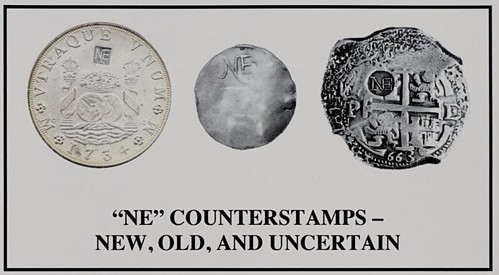
PREV ARTICLE
NEXT ARTICLE
FULL ISSUE
PREV FULL ISSUE
THE ELUSIVE NEW ENGLAND COUNTERMARKOne of my pastimes in recent weeks has been compiling for the Newman Numismatic Portal citations of articles on numismatics published in The Historical Magazine. The publication began in 1857, before there were numismatic societies and specialized numismatic publications in the United States, and I'm fortunate to have a bound set in my library. One frequent writer in those early days was Jeremiah Colborn of Boston whose "J.C." initials ended his contributions to The Historical Magazine. In the January 1857 issue (Vol. 1, pgs 372-373), Colburn republished a passage from Joseph Felt's 1839 work, An Historical Account of Massachusetts Currency. Here's the text of the article, carefully transcribed exactly as printed - spelling, capitalization, punctuation and all. I've done my best to reproduce this here. Many thanks to NNP's Kelli West of Washington University in St. Louis for her great work on this. -Editor QUERIES.
Pieces-of-eight under weight of 6 Shillings shall pass for so much of N.E. money as they weigh, and "that it be impressed upon the stampe how much each peece doth weigh, in legible figures with the other letters on the same and of the same alloy." "1701. At this date, there was a scarcity of change. Such an occasion was followed with its usual consequences. Regardless of their irregular example and bent on their own convenience and gain, not a few individuals stamped pieces of brass and tin, and palmed them on community at a penny each. They were speedily commanded by the Legislature to withdraw from their course or be fined and imprisoned."- Massachusetts Currency, by J. B. Felt. Have any of the readers of the Hist. Mag. ever met with any of the coins marked as above, and if so, will they communicate the fact to the H.M.? J.C.
My question to readers is the same one asked by Colborn in 1857. Is anyone familiar with a genuine example of a Spanish dollar countermarked with its weight as described by Felt? I'm familiar with regulated gold and of course the New England shillings coined by John Hull with their "N.E." stamp, but I'm not familiar with New England countermarked Spanish silver dollars. A search in NNP located one reference to the elusive New England countermark. It's by Ken Bressett and was published in the Summer 2015 issue of The C4 Newsletter from the Colonial Coin Collector Club. Here's an excerpt. -Editor  A Massachusetts Court Order was passed in 1672 authorizing the marking of fullweight Spanish pieces-of-eight with the letters "NE" to confirm their value as six New England shillings. Boston minters John Hull and Robert Sanderson were appointed to test and so mark coins that met the Court's requirements for weight and purity. A reference to this order became generally known to numismatists through publication in An Historical Account of Massachusetts Currency by Joseph B. Felt in 1839. Since that time researchers and collectors alike have hoped to locate examples of such coins to confirm adherence to the ordinance. In 1875 a second and even more widely circulated publication, The Early Coins of America by S. S. Crosby, also published the Act with Crosby's personal comment: "We have been unable to find any coins proving this Act ever to have been put in execution, although we have long sought for them." There is no evidence that any of the silver coins of that period were ever stamped in accordance with the ordinance. Indeed there was no pressing reason to do so and no convenient means of doing so. The Act of 1672 setting the value of eight-real coins at six shillings remained in effect until 1683 and effectively removed any incentive for having those coins converted to Massachusetts shillings, or counterstamped with any sort of markings. The earliest report of a "NE" counterstamped coin was in an article written by well known collector Matthew Stickney and published in 1860. In his persuasive account Stickney claimed to own such a coin and described it in detail without sighting from whom it was obtained. A detailed account of this is presented here under the record of the coin termed "A." It offers compelling evidence of the existence of a genuine coin meeting the requirements of the Massachusetts Act of 1672. Yet no such coin has ever been reported or unmistakably described elsewhere, and there exists no indisputable evidence that Stickney ever possessed such a coin. None was included with his "entire collection" when it was sold at auction in 1907. Various opinions have been expressed over the years that either support or deny the existence of coins associated with this Act. A number of coins do exist with a persuasive "NE" counterstamp indicating they may have been made in compliance with the order. An equally convincing argument can be made for the improbability of those coins having a contemporary stamp. This paper examines each of the known specimens and presents as much factual data as is available in a quest to determine the authenticity of any of these pieces. Researching these controversial coins has been an ongoing and intriguing task of mine, and others, for many years. Bresett's extensively researched paper seems to be the last word on this enigmatic subject. The Stickney specimen has either been lost or never existed. All the known pieces surfaced beginning in the 1950s and are genuine coins with a modern countermark applied. -Editor Ken Bressett adds: "Nothing further has shown up since I wrote the full exposé." References on the Newman Portal, see:
 Wayne Homren, Editor The Numismatic Bibliomania Society is a non-profit organization promoting numismatic literature. See our web site at coinbooks.org. To submit items for publication in The E-Sylum, write to the Editor at this address: whomren@gmail.com To subscribe go to: https://my.binhost.com/lists/listinfo/esylum All Rights Reserved. NBS Home Page Contact the NBS webmaster 
|